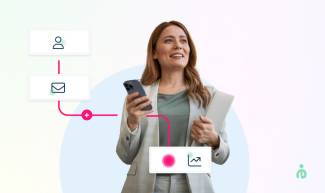A Foolproof Guide on Creating Irresistible B2B Email Newsletters
Email marketing is gold, and B2B markers know this, as 59% of them suggest that it’s their best strategy for yielding their revenue according to a study carried out by Btop Magazine.
Unlike B2C newsletters which are often loaded with hard sells, compelling copy, promos, and other forms of conversion-based marketing, B2B newsletters are a totally different ball game. Here, you want to show them facts, not feelings.
We’re talking figures, real-time developments, and how they can ride that wave to increasing profitability. Your email’s likely destination is in the spam folder if you’re not offering something mouthwatering. Something that tugs at their point of need. Something containing an overwhelming proportion of value-of-use.
Email Newsletters demand a certain awareness, that it’s different strokes for different folks. In the business world, B2B is that less-spoken-about goose that lays the golden eggs, and it’s safe to suggest that they suffer from an attention scarcity of sorts because they’re busy attending to their own customer’s needs.
Bloomberg (one of America’s largest B2B SaaS firms) makes an estimated $6.5Billion in annual revenue from just about 325,000 firms in high finance who pay monthly for access to their Bloomberg terminals. A consumer tech firm would have to sell millions of products to earn nearly as much. However, for all their differences, B2B relationships still bear notable similarities to B2C.
Email newsletters for B2B have a certain cadence they follow to achieve optimal results. For one, you need to offer a solution to your customer’s present or future business problem. In the absence of one, you should offer industry-specific nuggets, insights, best practices and trends to raise the roof on the business efficiency of the business.
We’ve got a clue about what’s probably popping in your mind right now — “aren’t all my competitors sending newsletters already?”. Alas. Yes. They probably are. But you’re one up because you beat them to this post. (Congrats!) There goes your competitive edge as they haven’t yet unpacked how and how NOT to use email newsletters, and which right newsletter tools to use.
We’ll be providing you with some extra exclusive tips on tools and trustable techniques that, if applied correctly, will position you as a PROBLEM SOLVER (Ask around. Problem solvers are a business owner’s bread and butter), comfortably nudging you miles clear of your competitors.
Craft ‘Must Read’ Content
It’s one thing to create engaging content. It’s quite another to create content that your customer knows that they miss out on at their own cost.
Must-read content ticks one or more of the following boxes:
- Solves a client-acquisition gap. (More clients, more revenue. Got it? Good.)
- Solve a management/administrative issue — All businesses are looking for the next best thing to tip the scales in their favour and make their job easier.
- Helps them get better ROI for their investment budget. (A better ROI is every B2B’s holy grail)
- Gives them a heads up about future trends to stay ahead of the curve.
Now, let’s face it, churning out quality content like this on a regular without feeling like a rehash of an earlier newsletter can be tough. So, we get that a lot of marketers may move to fill their email newsletters with boring, unnecessarily frigid content that only reflects a creative drought if anything.
Remember, your email newsletter will be read by human employees at the recipient companies who also most likely bear some responsibility for maintaining the relationship between their firm and yours. Thus, your newsletters must be written just like you would an individual customer—fun, informative, and ENGAGING.
Below, we outline a few tips for creating engaging content for your newsletters.
— Segment
One very important mistake that businesses tend to make in this space, is to treat all of their customers the same way. You’re probably thinking – “We’re a SaaS firm, all our clients just pay the same subscription fees to use our software”. Well, have you considered that these clients may often be in diverse industries? And sometimes, in different countries or continents? Different circumstances, different data segments, different PAIN POINTS.
When onboarding clients, you’ve most likely had them submit some of this data. All you have to do now is to segment your email list across the lines of difference. People are more likely to respond positively when they feel that their needs are being addressed, personally. Our Segmentation tool at Apsis One does an excellent job of that.
Segment your email list, and then tailor the emails for each group to the specific needs of their industry. For instance, if you provide a software service to a mining company and an FMCG (Fast Moving Consumer Goods) company, you’d be better served to craft an email newsletter with some mining content specifically tailored to the mining company and another for the FMCG than to send a bland, blanket newsletter that feels like a shameless plate of copy-pasta.
— Show how to get more from your product
Another surefire way to create content to make your newsletter more engaging is to show your clients how to get MORE from your products. Every so often, products usually have more uses than is generally known. Also, it may be that clients tend to use the product incorrectly or for other uses than it was intended for.
With one section of your newsletter dedicated to these product tutorials, you can provide value for your clients not only by helping them get the best use out of their purchase but also by preventing unnecessary breakdowns and maintenance visits, thus strengthening the business relationship even further.
— Profile your most popular products
It’s human nature to always want the best. But, oftentimes, the “best” is just whatever has more popular support. So, it's not out of place for people to want to buy a particular product, not because they genuinely think it’s the best, but because most other people think so.
You can take advantage of this and also, make your newsletter quite fun at the same time. What you need to do is include pieces on your most popular products. Depending on the product, you could use sales metrics or download metrics to show exactly why this product has every one of your customers gushing over it.
— Guide readers to your blog posts
Another interesting way to spruce up your email newsletters is to include guides to your recent blog posts. Any firm that wants to maintain its competitive advantage must leverage ‘digital’ and maintain a blog that dishes scoops on scoops of industry insight in a fun, relatable way (hello, Apsis One!) But you can get more juice from this squeeze. It doesn’t just stop there. You could also use these blogs in your newsletters.
We’re not advocating a rehash of your blog post in the newsletter. You can slightly tease it in your newsletter’s content and then slap a link on it. You’d be surprised how many new blog visitors (leads) you gain.
— Infographics
There is no need for your newsletter to be just an unattractive block of drab text. Throw in a bit of colour here, fanciful illustrative diagrams there and your newsletter’s looking not only attractive to the reader but also ‘quite the part.’
Images have been shown to make the reading experience a bit more fun and enjoyable. And what better images to use than infographics describing some industry numbers? Instead of just droning on and on about what prices are increasing and what effects the changes are going to trigger down the value chain, why don’t you create infographics to explain?
— Quizzes & Surveys
This is pure engagement, like, literally. Quizzes, surveys and polls are quite phenomenal tools. Not only are they awesome at generating reader engagement with content, but they are also a very practical way to get instant feedback, and can be quite entertaining too. Infuse them with a little fun, suspense, and watch your open rates soar.
— Company news
The whole purpose of running a newsletter is to keep the audience abreast of happenings in the industry and the company and how it might affect them. So, your newsletter won’t be complete without news of possible upgrades, new products, new management and whatnot. The more information that you can share with your subscribers, the more included they will feel. Nothing helps build business relationships better than transparency.
— Pull back on the sales pitches
Probably the most important. Cut down on the ‘sale-sy’ vibe of your message and similar tone in your newsletters. Of course, the ultimate goal of everything here is to make more sales and increase revenue. But, in this case, this won’t happen if they feel they’re being harangued by the stereotypical insurance sales agent who cares about nothing else other than to close a sale.
How to create newsletters
Knowing the right tools and rules to follow for creating newsletters is the foundation of this topic. Let’s outline three rules that you must follow in creating a newsletter.
— Pick a solid medium
The first thing that you’re going to want to do is pick the right newsletter tool for your newsletters. There are quite a few brands on the market, there’s Mailchimp, Hubspot’s Email Marketing Tool, GetResponse, Mailup, Drip, ConvertKit, and a few others. However, in choosing, you’ve got to be sure to pick one that is best suited to handle the length of your email list and won’t make your emails end up in spam folders.
Apsis One is a specialised tool built to handle email marketing strategies. With this tool, not only can you segment your email list based on demographic data, you can use the “consent list” to group your clients based on the information they consent to receive, taking email personalization to a whole new level.
Available data supports the success of these methods. In the past year, Apsis’ clients sent over 5.6 Billion emails through the system, with an average open rate of 27%. For context, the general average open rate for email marketing worldwide is just 18%.
— Pick a theme
After you have picked your newsletter tool, proceed to pick a theme, colour schemes, font styles and even writing styles. Choose carefully, because whatever you pick is going to become synonymous with your brand over time as readers clients see your newsletters more often.
— Create a schedule
Finally, create a schedule and be consistent. You may do it bi-weekly, weekly, fortnightly, monthly or quarterly, it doesn’t matter much. What matters is consistency, helpful content, and over time, clients will look forward to receiving your newsletters.

… Break Loose from boring B2B
Insightful newsletters are the cornerstone of developing your identity as a brand in B2B. Attractive newsletters are always a plus—every business wants to hang out with the cool kids. And churning email newsletters revealing how much they SHOULD be making from XYZ industry trends and how they CAN apply it by simply tapping a link to XYZ on your blog? You’re sure to have them swooning in delight and ‘complying’ with your CTA. (because you call the shots here. You earned it—with a kick-ass email newsletter).
Looking for insight into your email marketing performance? Take a look at this Email Benchmark Report to find out everything you need to know. Apsis One has proved its immense value by consistently being the COMPLETE email marketing tool. Whether automated emails or segmented content or even consent lists, our features are the ultimate competitive advantage you need.
Why don’t you join the winning team today? Book a demo to get the hands-on experience!


